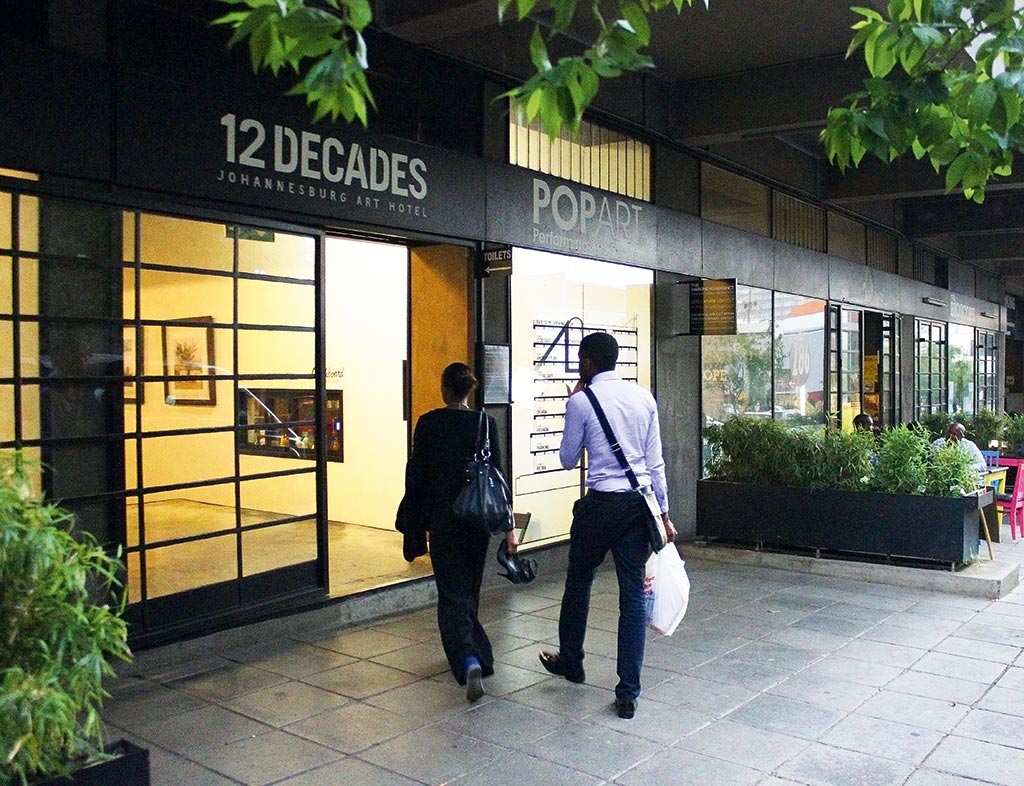There was a time, in the not-so-distant past, when downtown Johannesburg was the sort of place people avoided: run down, dangerous, nothing much to see or do. Now, however, the eastern central business district is a destination in its own right. It’s still run down – in terms of overall appearance, the area can’t compare with plush northern suburbs like Sandton or Rosebank – but these streets, with their trendy bars, shops and cultural amenities, are now safe to walk. And there’s a real buzz about the place.
This is in large part thanks to Arts on Main, a converted turn-of-the-twentieth-century warehouse containing exhibition spaces, artists’ studios, shops, a restaurant and a Sunday market, which now stand at the heart of a new precinct known as Maboneng. Four years on from the development’s launch in April 2009, and with thousands of visitors making their way to Arts on Main and other Maboneng destinations each weekend, now is a good time to evaluate the venture’s success.
A lot of people who swore they’d never come into the inner city because it’s so dangerous are coming in
Property developer Jonathan Liebmann, founder and CEO of Propertuity, the company that in 2008 bought and converted the vital warehouse, recalls his feeling of frustration at “not having an urban alternative” to life in the suburbs of Johannesburg. What was once a thriving manufacturing and commercial area fell into disrepair as a result of the decline in industry and white flight following the fall of the apartheid regime. High crime rates – a by-product of high unemployment among the economically disadvantaged communities that moved into the city centre – had made downtown Johannesburg a no-go zone.
Streetwise solution
The solution, Liebmann felt, lay in an arts-focused regeneration plan. “If you look at all successful regeneration projects they often have artists as their first occupants and those artists and galleries are the catalysts for the site change. And the reason why that happened, at least in this area, is because it’s affordable and it has really good quality of light: there’s double, triple volume ceilings. Also I think artists like to align themselves with social change and rejuvenation projects.”
David Krut Projects (DKP) was one of the founding arts organisations at Arts on Main, opening a bookshop, print workshop and exhibition space there in April 2009. Krut has been active on the South African contemporary art and publishing scene since the early 1980s, known in particular for his long association with William Kentridge, one of the country’s most prominent artists.
Kentridge has also been involved with the development from the very beginning, working from a large studio space there and collaborating regularly with DKP. Liebmann says that when he first set the wheels in motion “people thought I was crazy”. Kentridge’s early involvement was crucial when it came to attracting the interest of established organisations such as DKP, the Goethe Institut and the Goodman Gallery, another major player on the Johannesburg art scene.
Krut is very positive about the way Arts on Main has catalysed a transformation of the surrounding area, but draws a distinction between the project and the sort of true artist-led cultural regeneration that has taken place in other cities. “I was around in London in the 1970s when Wapping came to life,” he says. “There were artists living there, there was no water, they weren’t supposed to be there. [In Johannesburg] artists weren’t coming in and making it happen, that didn’t happen here: it wouldn’t have been safe and there were no usable facilities. So the regeneration has had to come in a more
sophisticated way.”
Beyond art
Although art kicked it all off, it wasn’t long before Liebmann was hatching further plans. Propertuity now owns 34 buildings in the area and has developed seven of them into a new precinct, Maboneng (which means ‘place of light’ in Sesotho, one of South Africa’s 11 official languages). Today, 70 percent of Maboneng is residential, with workspace and retail making up the rest.
Not all the galleries that set up project spaces in the early days of Arts on Main are still operating there today. The Goodman Gallery, for example, moved out just over a year ago. For gallery owner Liza Essers it just didn’t make commercial sense to maintain a permanent space there in addition to the flagship site on Jan Smuts Avenue, the city’s contemporary arts hub. She hopes instead to stage pop-up exhibitions on an ad hoc basis at spaces in Maboneng, exploiting the ‘cutting-edge’ nature of these new environments while maintaining flexibility of programming. Essers regards Arts on Main and other ‘creative hubs’ that have come into being in the city over the last few years as “very necessary to grow a contemporary art scene” in Johannesburg.
Commercial challenges
DKP is going strong at Arts on Main but Krut acknowledges that there challenges concerning commercial viability. His space works, he says, because it combines bookstore, print workshop and gallery, each aspect of the business helping to support the others.
“It’s not a sophisticated art collecting audience… [There’s] a long road before [Arts on Main] becomes anything like the epicentre that the Jan Smuts arts strip is,” Krut says. “And even there, there are only about eight or nine galleries and that includes the top ones in the country… It’s still a pretty small gallery environment in South Africa.”
But even if the visual arts provision at Arts on Main is still relatively modest, there’s no arguing with the way culture in the area has blossomed more generally. A pop-up comedy club, an independent cinema and a design hotel are just a few of the artsy options drawing crowds – including, crucially, plenty of foreign tourists – to a part of town that five years ago was effectively off-limits.
“A lot of people who swore they’d never come into the inner city because it’s so dangerous are coming in,” says Krut. “They’re just staggered at how fabulous it is.”





